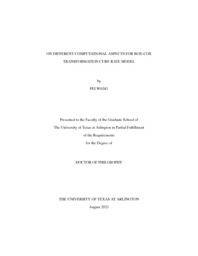
ATTENTION: The works hosted here are being migrated to a new repository that will consolidate resources, improve discoverability, and better show UTA's research impact on the global community. We will update authors as the migration progresses. Please see MavMatrix for more information.
Show simple item record
| dc.contributor.advisor | Pal, Suvra | |
| dc.creator | Wang, Pei | |
| dc.date.accessioned | 2023-06-28T14:25:28Z | |
| dc.date.available | 2023-06-28T14:25:28Z | |
| dc.date.created | 2021-08 | |
| dc.date.issued | 2021-08-16 | |
| dc.date.submitted | August 2021 | |
| dc.identifier.uri | http://hdl.handle.net/10106/31358 | |
| dc.description.abstract | Cure rate modeling is an emerging area of research not only in biomedical science but also in other disciplines such as sociology, criminal justice, economics and engineering reliability. In the first part of this thesis, use of the wider class of generalized gamma distributions is proposed as the distribution of the lifetime for a particular transformation cure rate model, known as the Box-Cox transformation cure rate model. The maximum likelihood estimation of the Box-Cox transformation cure model parameters is studied through the calculated bias, mean square error and coverage probabilities of the asymptotic confidence intervals. The flexibilities of both generalized gamma distribution and Box-Cox model are utilized to carry out power studies to demonstrate the power of the likelihood ratio test in rejecting mis-specified models. Furthermore, the bias and efficiency of the estimators of the cure rates are studied when a wrong lifetime distribution is specified for a given cure rate model as well as when a wrong cure rate model is specified for a given lifetime distribution. The studies strongly suggest the importance of selecting a correct lifetime distribution and a correct cure rate model, which can be achieved through the proposed Box-Cox model with generalized gamma lifetime distribution. An illustration of this two-way flexibility is provided using data on breast cancer study.
In the second part of this thesis, the mixture cure rate model is considered as a special case of the Box-Cox transformation cure rate model. Instead of modeling the incidence part by using the traditional logistic or sigmoid link function, a new modeling approach based on the support vector machine (SVM) is proposed under the assumption of interval censored data. The proposed approach inherits the features of the SVM and provides flexibility to capture non-linearity in the data. A new estimation procedure based on the expectation maximization algorithm, that makes use of the sequential minimal optimization technique and Platt's scaling method, is developed to estimate the model parameters. The results of an extensive simulation study show that the proposed approach performs better in capturing complex classification boundaries when compared to the existing logistic regression-based approach. It is also verified that the ability to capture complex classification boundaries improve the estimation results corresponding to the latency parameters. For illustration, the proposed approach is applied to an interval censored smoking cessation data. | |
| dc.format.mimetype | application/pdf | |
| dc.language.iso | en_US | |
| dc.subject | Cure rate mode | |
| dc.subject | Generalized gamma distribution | |
| dc.subject | Box-Cox transformation | |
| dc.subject | Support vector machine | |
| dc.subject | Expectation maximization algorithm | |
| dc.title | ON DIFFERENT COMPUTATIONAL ASPECTS FOR BOX-COX TRANSFORMATION CURE RATE MODEL | |
| dc.type | Thesis | |
| dc.date.updated | 2023-06-28T14:25:28Z | |
| thesis.degree.department | Mathematics | |
| thesis.degree.grantor | The University of Texas at Arlington | |
| thesis.degree.level | Doctoral | |
| thesis.degree.name | Doctor of Philosophy in Mathematics | |
| dc.type.material | text | |
| dc.creator.orcid | 0000-0001-6386-7590 | |
| local.embargo.terms | 2023-08-01 | |
| local.embargo.lift | 2023-08-01 | |
Files in this item
- Name:
- WANG-DISSERTATION-2021.pdf
- Size:
- 16.08Mb
- Format:
- PDF
This item appears in the following Collection(s)
Show simple item record


